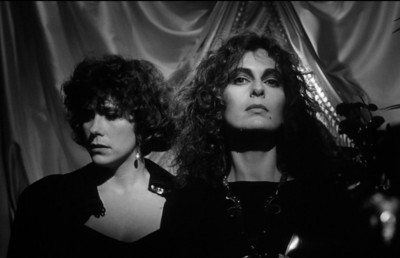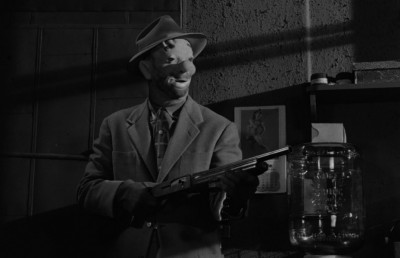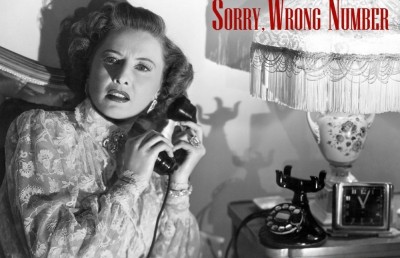Dark Tales from Hollywoodland
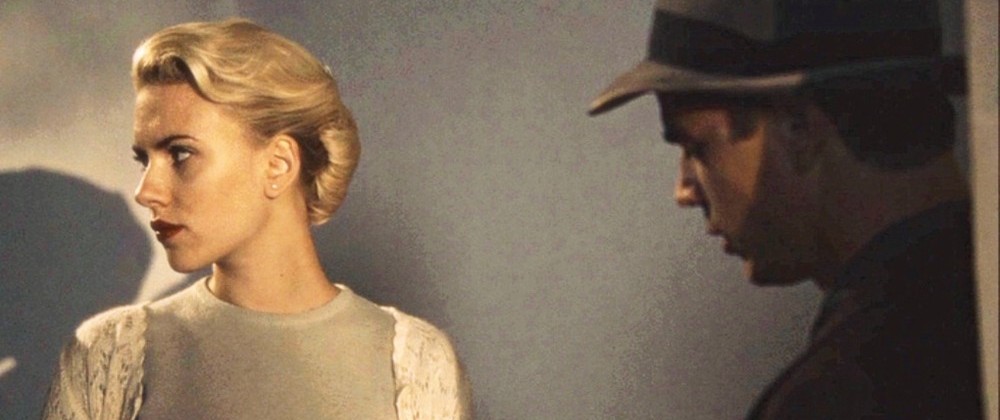
I never knew her in life. She exists for me through others,
in evidence of the ways her death drove them.
(James Ellroy, The Black Dahlia)
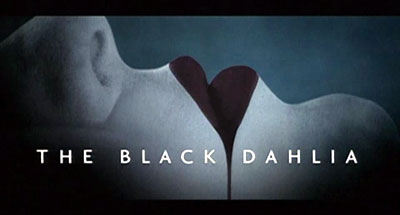
39th and Norton
From a distance, we can hear crows croaking. We notice their ominous presence only if our senses are attuned to horrible things. Most people do not notice their cries, but the camera seems to be lurking further than it should, as if trying to signify danger. A woman runs in the distance, alongside a vacant lot, trying to get the attention of the people around. She stands as a red herring, a signifier of fear and fatality, but the camera is called elsewhere, and with it the spectator must leave the scene, unaware of the torments that are taking place on the other side of the street.
Still unsolved, the murder of aspiring starlet Elizabeth Short remains the most famous crime in the history of Los Angeles. With her murderer unknown, and a long list of emotionally distraught investigative officers, Betty Short became the most well-known victim of Hollywoodland in 1947.
As with a writer obsessing over writer’s block, the story of a detective obsessing over an unsolved murder case can be interesting fodder for drama. While it can easily fall into the trap of running around in circles, some tales of obsession have given inspiration to some remarkable pieces of filmmaking and literature. Such stories seem to have been explored in more depth in recent years, with certain authors known for their obsessive subject-matter, reinventing manias that haunt them. One such writer is James Ellroy, who wrote The Black Dahlia based on his own story of the black dahlia case, as well as the brutal murder of his mother in Los Angeles in 1958. [1] While exploring the boundaries of hard-boiled fiction, it was only natural that he would steer toward the moody atmosphere of film noir; the flavor of his speech was unmistakable: the dahlia story was not only black; it was noir.
Another noir aficionado was to tumble upon the story years later. Brian De Palma, who directed numerous films with noir elements and is a subscriber to the gangster genre, was given the The Black Dahlia to direct, a not-so-easy task given the density of the plot lines. His additions to the story were mainly aesthetic, respectfully transcribing Ellroy’s crisp language and shadowy vision to the screen. Over the next several paragraphs we will look at how the film belongs to the true crime genre, and the affects it casts on the spectator’s endurance, by analyzing in detail the autopsy scene, and the police procedural aspect of the film. Furthermore, we shall also be looking at its association to the noir genre and the detective’s psychology, which, in this case, slowly deteriorates into obsession. Finally, we will analyze the aspects of reflexivity and auteurism found in De Palma’s film, by looking at some key scenes referencing previous cinematic works. While working through the many levels of ??The Black Dahlia??’s involvement in crime/noir, this essay will function as a comprehensive guide through the aesthetics and thematics of De Palma’s film.
A film about a body
It would be pointless to list every reason why The Black Dahlia belongs to the (neo) noir filmography. Nevertheless, what seems obvious for some may sound like just-another-complicated film for others: Which is why I was amazed to see so many people leave the theater during the film, confused perhaps by the complicated plot line, or simply bored by what, from an outsider’s viewpoint, can easily look like the gimmicks of a filmmaker trying hard to render a certain look or feel of a past genre. Some have also labeled The Black Dahlia as too academic, implying that De Palma had wanted to make a literal 1940s film noir. Instead, I would argue that the result is so impregnated with noir elements that the naturally emanating atmosphere closely resembles the films noirs of the golden era, in essence bringing the film to a higher standard: achieving what 1940s-50s noirs could render in ambience and mood. From its narrative instabilities, to its exaggerated aesthetics, The Black Dahlia breathes noir to the bone.
Detectives Dwight “Bucky” Bleichert (Josh Hartnett) and Lee Blanchard (Aaron Eckhart) are partners at the LAPD homicide squad after careers in the boxing ring. When the body of a young woman is discovered in a ditch, her body brutally mutilated, the two start investigating. But as the case staggers, Blanchard becomes completely obsessed with the dead woman, neglecting his fiancée, Kay (Scarlett Johansson). When Lee gets murdered, things fall apart for Bucky, caught in the web of a femme fatale, Dahlia-look-alike named Madeleine (Hilary Swank), whose strange family seems somehow tied to the dead girl. On a quest to find her killer and avenge his late partner’s obsession, Bucky discloses many hidden truths, corruptions and lies, in pure noir fashion.
The novel and film are a perverse fictionalization of the real case; they present their own evidence and draw their own conclusions. The book, reputedly inadaptable, lingers on Bucky’s obsession in finding Betty’s killer, which takes him to the year 1949, two years after the murders of Short and Lee (while the film compresses it all in a few months). Completely gripped by her, Bucky details every step he undertakes to find her murderer, his fascination coming dangerously close to madness, cloaked in an aura of necrophilia.
The Black Dahlia??’s gloomy atmosphere comes largely from the fact that it is deeply anchored in true crime. The black dahlia case has never been solved; it remains the most notorious case in the history of crime in Los Angeles since 1947. The horrific murder of Elizabeth Short has taken its place in the annals of the Los Angeles Police Department, only to be revived from time to time, sometimes for the sake of a fake confession, sometimes for the purposes of a film in need of factual evidence. What we qualify as true crime is a non-fiction genre in which the author uses a real crime as their point of departure, whether to make it sensational or a plain rendering of the facts. The concept of true crime had been introduced to popular culture in the 1950s, as a result of the emergence of tabloid newspapers across most countries in the 1920s, which made public facts and figures of famous crimes. True crime, with its share of dreary, glum facts, has been the source genre of some important filmic and literary oeuvres (Truman Capote’s In Cold Blood, David Fincher’s recent ??Zodiac, among others). De Palma’s film uses the true crime origin to a certain extent: the effect of adapting true crime to the screen is impressive, and knowing that the facts laid before us aren’t fictitious, adds a great deal to the overall ambience of the film. Elizabeth Short was cut in half at the waist, her body removed of all interior organs and blood. Her face had been cut from ear to ear in the shape of a smile, a cruel farce, and certainly a gruesome and horrifying gesture. These facts alone are enough to repulse, but when you add to it the imagination of a director, the result can easily fall into the trap of sensationalism.
True crime is frequently marked by descriptions of police investigations, which are even more deeply analyzed in police procedural films than in other true crime movies. Films or novels of the police procedural genre depict the work of police officers in their daily lives and daily routines. Offering a clinical look at their techniques and methods, the films that fall under the banner of police procedural linger on such details as the autopsy, unlike in the whodunit genre, which focuses more on the result (who has perpetrated the crime) than the investigation itself (the gathering of evidence, etc.). Hence, the precinct [2], the ‘office’ of the policemen, is a primordial component of the genre, their lieu of reunion, discussion and reflection, when not out on the streets. The LAPD’s precinct in The Black Dahlia, with breath-taking architecture, is a major décor throughout the film, a grand and imposing place –very far from The Shield’s barn or ??NYPD Blue??’s 15th Precinct.
Indeed, an important aspect of true crime is the autopsy, which is represented in Black Dahlia in an interesting manner. The autopsy scene starts with the procedure already in progress. The corpse is lying on the operating table, with policemen gathered around it. The camera assumes a bird’s eye point-of-view, but the corpse is hidden from view by the men bent over the table. You can see the body, but yet you do not really see. The camera zooms in, some men move, and the body fully appears. The effect is then less shocking, as if De Palma had wanted to spare his viewers.
Rien n’est plus proche de la fiction que ce document brut […] l’éparpillement d’un corps qui nous est montré tel qu’il est: de la matière. […] Spectacle analogue: celui d’une véritable autopsie, rarissime au cinéma. Le choc d’une surprise (l’absence de sang) est loin d’atténuer l’effet de malaise irrépressible devant le découpage méthodique de ce corps étranger, qui est pourtant le nôtre – effet toujours pressenti et jamais ressenti dans les films de fiction (policiers, etc.) où l’autopsie se déroulait toujours, bien sûr, hors champ. [3]
What Gérard Lenne enunciates here is the presentiment of the autopsy, the dread of the act itself, but also its meaning, its intrusive character. Here too, the autopsy takes place off-screen –contrary to, say, the CSI: Crime Scene Investigation series, in which a medical examiner performs thorough autopsies in an extremely detailed and graphic fashion– but the medical examiner relates and states every point in very precise wording.
Another one of the strengths of The Black Dahlia rests in the development of the detective’s psychology: the mal-être of the detective, confronted with his own personal demons when assigned to work on a case that triggers in him some deeply hidden feelings. The obsessive nature of the story resonates louder due to its author, Ellroy, who lives haunted by the brutal, unresolved murder of his mother, which he exploits in his version of the black dahlia story. On the thresholds of insanity, the detectives of The Black Dahlia get entangled in a case that staggers, but which they will never let go. In this specific way, the film links with the serial killer film, a genre in which obsession takes on an important role: the nature of the serial killer being to kill more than one person (three, to be exact factually), the police force must act rapidly in order to prevent other killings, which demands that the officers be constantly working on the case. In the real dahlia story, speculations have for a long time associated the dahlia as the victim of a serial killer, but never has this track been confirmed through other victims.
Film noir is about death; and The Black Dahlia centers around a dead body which is omnipresent throughout the whole film. As characters talk about the dahlia’s death, they are confronted with their own: Lee’s slow descent to hell, Kay’s fear of De Witt’s aggressions, etc.
The objective status of death in film noir narratives is often convoluted, confusing, opaque. […] Given the mutability of personal identity in film noir it is not surprising that there is a constant horizon of death—represented through explicit verbal reference, narrative action, and overall narrative structuring—and that this horizon is fraught with considerable ambiguity: who will die, and will that injunction be a final or transitive stage? No other group of films in Hollywood history treats this subject with such pervasive concern or with such emblematic uncertainty. [4]
The grounding The Black Dahlia has in Los Angeles culture is also noteworthy. The city, so often portrayed in film noir, has played many parts in the portrayal of urban decadence so often linked to the true crime genre. Raymond Chandler was the first to write about the city as a character per se, one that could incite any good man to do the darkest deeds. Somehow The Black Dahlia illustrates this in the sense that Bucky, without any antecedents of madness, gets driven to the brink by an unresolved murder anchored in the Hollywood dream: an aspiring actress coming to Hollywood to become a star, who not only gets murdered, but vivisected.
As Alain Silver and James Ursini express in L.A. Noir: The City as Character, “Los Angeles is the quintessential dramatic ground of film noir.” [5] In The Black Dahlia, the city of Los Angeles acts as a décor. Unlike other films noirs (John Huston’s The Asphalt Jungle, 1950, for example), Los Angeles is here portrayed in a romanticized manner. A great part of it is shown: the riots at the beginning of the film taking place in streets and alleys at night, the cinemas, clubs and bars with their neon lights, the Red Arrow motel, the vacant lot at 39th and Norton –and its neighborhood– and lastly, the Mount Lee neighborhood, where the Hollywoodland sign sits, looking at the desolated houses of the Hollywood Hills district.
Some of these reasons are significant in helping to comprehend the film’s dense narrative; labyrinthine to the extreme, De Palma’s film refuses clarity to the benefit of its atmosphere. The Black Dahlia is undeniably a rich film. If hard to read, it is only such because it is deeply grounded in elements which some viewers may not be familiar with: its noir character.
No film noir is easy: while shooting The Big Sleep (1946), Humphrey Bogart was confused as to who had killed a certain character. When he asked Howard Hawks, the director, Hawks could not respond, so they called Raymond Chandler, the author of the novel, who told them he did not know either. [6]
Some could criticize the film for its archetypal aspect. I would say, on the contrary, that the richness of The Black Dahlia rests in this simple fact. Because it so thoroughly uses many noir archetypes –the corrupt cop, the damsel in distress, the private eye who can not be stopped from uncovering the truth, the femme fatale– the film reaches high levels of enjoyment for the noir buff, happy to tread familiar territory. Film noir remains an ambiguous aesthetic that can be manipulated in dramatically different ways –or in different dramatic ways. De Palma’s take on it is impressive, but James Ellroy’s hypnotic text is responsible for a lot too.
Elmore Leonard has said of Ellroy’s staccato language that it was “…high intensity prose. Reading it aloud could shatter your wine glasses.” [7] His language is bitter and haunted, worthy of the best hard-boiled literature, and his crisp, rhythmic language becomes alive in the film, mostly due to the flawless interpretation of Josh Hartnett, capturing Ellroy’s tone to perfection. Most critics have considered the film in a lesser light due to what they see as a less than convincing performance by Hartnett. I would argue otherwise: a bit like Joseph Gordon-Lewitt in Rian Johnson’s Brick (2005) or in The Lookout (Scott Frank, 2007), Hartnett seems perfectly at ease in crime thrillers, as he demonstrated in Lucky Number Slevin by Paul McGuigan, in 2006. Having the advantage of a voice worthy of the best noir narration, he manages to eclipse such failed noir narrators as Dick Powell in Murder, My Sweet (1944). Hartnett matches the role physically, but perfectly captures the tone of the piece; Ellroy himself has said that for the very first time a feature film adapted from his work had managed to cast an actor perfectly embodying one of his characters. If the actors of the film seem stiff in their roles, I would argue that it is a quality, for in the film they are not playing roles per se, they are playing archetypes, which is perhaps responsible for the impression of void in their expressions and reactions (for example, Scarlett Johansson’s interpretation of Kay reminds us more of an impersonation of an actress playing, rather than the impersonation of a character).
Dead Desire
As well as belonging to the true crime genre, De Palma’s The Black Dahlia is a film anchored deep in cinema itself. No doubt the film can be qualified as auteurist because of the many mise en scène traits associated with Brian de Palma (for example, his famous “split field diopter,” a technique which allows the character in the background to be as sharp as the foreground due to the placing of a supplementary lens). The period reconstruction, the quality of the images and of the artistic direction, as well as the sweeping camera movements not only demonstrate that The Black Dahlia is a great piece of filmmaking, but that it is a great noir piece.
The Brian De Palma mastery becomes evident 20 minutes into the film, when the body of Elizabeth Short gets discovered. De Palma tantalizingly holds the camera away from the corpse, which is a brilliant cinematic choice; for those having read the book, and even for those knowing the facts of Short’s murder, the discovery of such a cadaver inspires suspense worthy of the best horror films. The apprehension of seeing the horrific corpse reaches peaks of suspense, since the spectator knows he/she will be horrified and repulsed. De Palma’s clever trick is to postpone sight of the body, without lingering on the dramatic construction of the suspense.
As we hear crows croaking –a very clear sign, to someone who is attentive, that death is near– the camera slowly pans up to the top of the building, then passes over the roof and the crows to look out onto a vacant lot, where we see a woman start to panic and scream, while trying to alert someone. De Palma’s camera leaves the scene to come back to the street where Bucky and Lee are just about to get involved in a shoot-out. As the scene wraps up a few minutes later, Bucky finds himself on the second floor of the building when he hears a disturbance outside the building, apparently unrelated to their case. Police sirens sound and police car tires screech, as Bucky approaches a window to look out at the events unfolding. The camera follows him to track out of the window, looking directly into the vacant lot we saw before the beginning of the shoot-out. Several police cars are parked around something invisible to the viewer, but the nervousness and anticipation of the policemen announce that they are in for a gruesome discovery.
Throughout the film, the body is shown incrementally, recounting the dead body itself: from our first encounter with it to the autopsy, different approaches, different visions of it are offered. Changing in scale, the view of the body is first presented in an extreme long shot, the camera placed on a crane above the roof of a building, looking out on a wide vacant lot where the body has been dumped. From this high vantage the corpse resembles a tiny carcass in the immensity of a waste land.
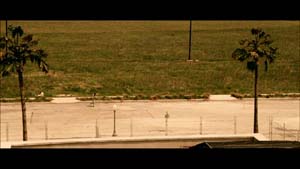
Moments later, when the police have arrived on the scene, the viewer is offered a closer look at the corpse, which is still not properly acknowledged: at that point we can only suppose; with the group of policemen working their way on the lot hiding the body, we can only make out glimpses of the corpse.
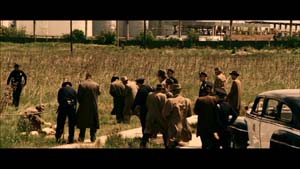
The horror on the faces of the policemen transmits the horror of the scene. The viewer is now aware of what might be hidden, aware also of its full impact and importance. Nauseous, horrified or looking away, the policemen gather around it, the camera sitting in the position of the body, looking at them looking at it.
At this point De Palma ventures a bit further: when a crow lands beside the body and Lee reaches to make it go away, the camera catches a fraction of the dead body almost in a close-up, enough to see part of the dahlia’s face, the beginning of her slashed mouth and her hand.
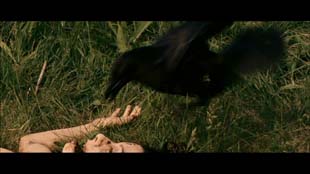
The next sequence showing the body is the autopsy scene, in which the viewer can once more get a look at the corpse, this time from a bird’s eye point-of-view. Again, De Palma takes his time. With the first seconds, as we explained earlier, he shows glimpses of the body on the operating table. As the camera zooms in, the body is revealed slowly.
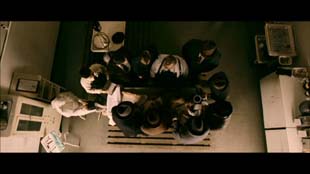
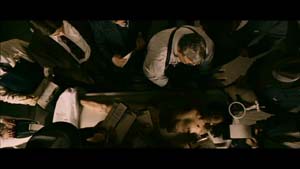
But what is striking in The Black Dahlia is the presence of the dead: the audition flashbacks in black and white interspersed throughout the film, in which the dahlia is interviewed by a casting director (De Palma himself). The absurdity of these scenes works to destroy our comprehension of the character: we are confronted with this vision of the living actress, but we know that she is dead. These sequences sit under the sign of fatality, working as reminders of the imminence of death; because all of this will lead to her death, just like the investigation itself, based on her life, while it is her death that matters.
You get the picture? –Technicolor
Certainly, De Palma is a filmmaker of the ultra-referential, like Tarantino, constantly recycling scenes or sequences created by his predecessors. With The Black Dahlia he pushes the limit higher, going as far as auto-citing himself. References are numerous, and if they are not acknowledged by most viewers, they are a true delight for the cinephile, especially for a noir fan. Our goal is certainly not to catalog them all, but a closer look at some examples can demonstrate how The Black Dahlia implicates –subtly or not– its own medium in the narrative, and the richness this adds when looking at the film as a whole.
Firstly, it is noteworthy to explain that the appellation “Black Dahlia” comes from cinema itself: Elizabeth Short’s nickname of “the black dahlia” comes from the fact that she was always dressed in black, and from the 1946 film by George Marshall The Blue Dahlia, which was out on the screens a few months before her murder. The Black Dahlia also references the cinema medium in incorporating names of real cinematic figures: David O. Selznick or Mack Sennett, or by showing the marquee of a theatre screening The Black Angel, a 1946 film noir by Roy William Neill.
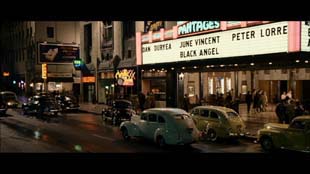
The sequence constructed at the Spragues’ mansion, in which everything is shot in subjective point-of-view, echoes Robert Montgomery’s Lady in the Lake (1947, adapted from Chandler’s novel), a film which was shot entirely from the POV of the main protagonist. The scene in which Bucky and Kay, after their first disastrous dinner without Lee, jump in each other’s arms and make love on the dinner table reminds us of the same scene in the 1981 version of The Postman Always Rings Twice, in which the two protagonists make ferocious love on the kitchen table.
The porn subplot is reminiscent of The Big Sleep (Howard Hawks, 1946), and the stag film shot with the dahlia directly references the stag films of early cinema. The film also references other crime genres, such as the Italian giallo, in the scene of Lee’s murder:
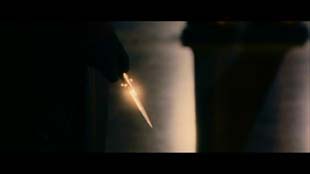
In the same scene, when Bucky is witnessing the murder of Lee, there is a shot quoting from Hitchcock’s Vertigo (1958), a reference that has almost become necessary in the films of De Palma, Hitchcock being the filmmaker he always looks to.

It would be false to say that the film does not exist on its own. However, some of its sequences tend to borrow from films to create sequences that are best appreciated when fully aware of the reference and of the work cited. This very common problem with intertextuality has the disadvantage of distancing most viewers, unaware of the references. Another weakness of the film can be found towards the end: the film loses its rhythm, and if it experiences a change of mood it is mostly due to the fact that a film noir, like police procedurals, is not supposed to expand too much on the guilty person, the motives of his/her actions, and the ways in which the crimes were perpetrated. The disappointing ending leaves us wondering whether or not it would have been better if the story had remained the same as in real life, unsolved, left open to interpretation.
Brian De Palma has created a film impregnated by the cultural identity of its author; a film in which the aesthetics are sometimes pushed to extreme for no precise purpose, other than that of pleasing or teasing the viewer, who assumes the position of disempowered voyeur. Whatever happens, things will get undone. Fatality drives film noir, and whichever action the noir protagonists undertake, chance will not be on their side. As Bucky comes home to Kay, the crows are still croaking, and will always trigger in him the sight of Betty Short’s mutilated body. À la De Palma, the surreal sight of the corpse on the lawn appears as a haunting reminder: to Bucky, of Short’s death that cannot be illustrated by something other than a dead body, and to us, the viewer, that noir does not, cannot, exist without death.
What is fascinating is of how little importance Elizabeth Short is to her own story. In Ellroy’s and De Palma’s versions of the story, she is almost invisible, a transparent premise to allow a closer look at the many knots entangled around her. Nobody knew her, it seems, and still, I am sitting here writing about her….
Endnotes
1 Read My Dark Places by James Ellroy or watch James Ellroy: American Dog, a documentary by Clara and Robert Kuperberg (2006).
2 Thoroughly characterized in Ed McBain’s exhaustive novel series 87th Precinct, an indispensable element in the police procedural genre.
3 Lenne, Gérard. La Mort à voir. Poitiers/Liguegé : Les Éditions du cerf, 1977.
4 Arthur, Paul. Shadows on the Mirror : Film Noir and Cold War in America, 1945-1957. Ph.D dissertation, New York University, 1985, p. 76.
5 Silver, Alain and James Ursini. L.A. Noir: The City as Character. Santa Monica Press, 2005, p. 12.
6 McBride, Jim. Hawks on Hawks. Berkeley: University of California Press, 1982, p. 104.
7 In an editorial review.


